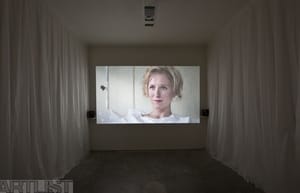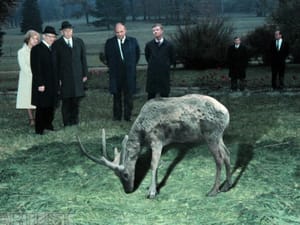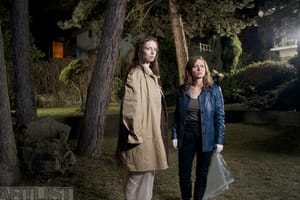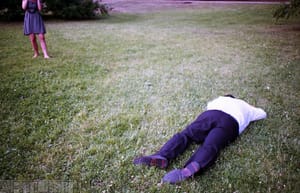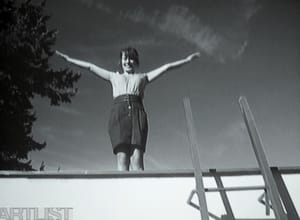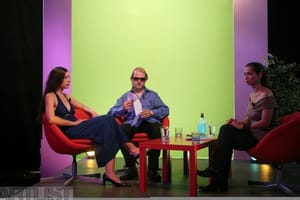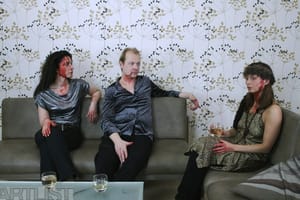- First Name
- Adéla
- Surname
- Babanová
- Born
- 1980
- Birth place
- Prague
- Place of work
- Prague
- Keywords
- CSU Library
- ↳ Find in the catalogue
About artist
Adéla Babanová (1980) belongs among the group of front representatives of Czech art who work with the politics of a moving image. Her work is anchored primarily in the media of film, which the artist uses to examine and observe aspects connected with the truth and perspective – or the subjectivity of storytelling, personal and collective memories, temporality, and their penetration in the relation of the narrator and collection of realistic (objectively known) and fictive prototypes, which determine the narration and its later interpretation. The majority of the work of Adéla Babanová is based on real factual events and stories, the archive documentation of which the artist uses to build a new story, its edited re-telling, or as a documentary part of a given narrative. A recent example of this is her work Return to Adriaport (2013) – a fictive film documenting the real project of Professor Karel Žlábek and Pragoprojekt from the year 1979, the objective of which was, with the help of a tunnel, to connect Czechoslovakia with the Adriatic Sea and turn the socialistic Czechoslovakia into a seaside country. With the use of period artefacts and extensive archive documentation Babanová treats a utopian vision and simultaneously remodels this vision – story into a realistic historical event. The artist points out here the power of the media of film, which is in essence built on human openness and desire to accept this reality as truthful and hence unknowingly eliminate the boundary between reality, fiction, interpretation and made up historical facts that often, in the course of time, thanks to the power and character of storytelling, become a shared part of collective memory.
We encounter the question of subjective and collective memory and the possibility of their manipulation also in the artist’s last film Where Did the Flight Attendant Fall From? (Odkud spadla letuška?) Similarly to Return to Adriaport, this is also an elaboration of a real event, specifically it is the story of flight attendant Vesna Vulović who was the only one to survive the airplane crash near
Česká Kamenice. In this case, the film focuses primarily on the interview with the flight attendant who lost her memory following the crash. The process of the (impossible) recollection is presented here as a form of manipulation, which rather than supporting the truthfulness about the event, tries to artificially read into it. The only witness of this accident, whose role is perceived from the position of some sort of universe of truth, is presented here as a weak but the only component in the formation of collective memory. The process of recollecting and memory in general are presented as an easily influenced component, the significance of which in the role of human history and the understanding of human history is quite fundamental. On one hand, with respect to historical context, one can read her work from the view of the Normalization era the objective of which was to maintain society in believing truths suitable for the regime, on the other hand, however, it is possible to view her work from a politically uncoloured perspective where the question of forming history and objective truths is independent of a regime, is instrumental and today, in many respects, it is very current.
Babanová uses a very specific film language in her films which is characteristic for a historicizing component – two of her latest films are set in the time of Normalization, and a new film that is in its preparation phase takes place in 1964. The artist accents the period aesthetic, which becomes one of the characteristic elements of her work. Staged reality naturally weaves with period artefacts here and further thins the already thin boundary between reality and fiction, memory and story, recollection and forgetting. As long as we still try to find the boundaries of this fine line through the characters, as was the case in the detective story Ich hab hier eine Leiche (Já tam mám tělo) (I Have a Body Here) from 2012, the result will most likely be just an analysis of complex relationships between characters and their subjective views, which multiplies the layers of the story and points to the fact that an objective view of history is rather a thing of subjective decision, which is built on the conscious rejection of the grey zone, which is a part of any depiction and grasp of reality or its history.
- Author of the annotation
- Markéta Stará Condeixa
- Published
- 2015
CV
Sudies:
2000 - 2006 Academy of Fine Arts Prague, Concept Departement (Milos Sejn), New Media Department (Michael Bielicky)
Awards and stipends:
2014 finalist of Dorothea von Stetten Art Award 2014
2012 finalist of Jindřich Chalupecký Award
2011 finalist of 333 Award, National Gallery Prague
2005 finalist of Essl Award, Academy of Fine Arts, Prague
2002 LVMH Award, Prix des jeunes créateurs, 3 months residency at the École Nationale Supérieure des Beaux-Arts, Paris
Exhibitions
- Solo exhibitions
-
2012
Ich hab hier eine Leiche, Jiri Svestka Gallery Berlin
2011
Potížistky, Galerie Jiří Švestka, Praha
Nikomu to nepovedala, jedine samotnému kňazovi, Nitrianská Galéria / Galéria Bunker, Nitra
2010
Už šedesát let je mi třicet, Galerie Kostka, Meetfactory, Praha
2009
Polobozi, cyklus Start-Up, Galerie Hlavního města Prahy, U Zlatého prstenu
Za umělce roku jsem zvolila sebe, Galerie 35M2, Praha
2008
Interview Zurich, Galerie mladých, Brno
- Group exhibitions not included in ARTLIST.
-
2012
Umělec je vyvolený, Galerie TIC, Brno, CZ
2011
NG 333, finále, Národní galerie v Praze, CZ
2009
I don´t wanna die but I ain´t keen on living either /jako host Eugenia Percossi/, Karlin Studios, Praha
Bad Filming, Galerie U dobrého pastýře, Brno
Double Blind, FaVU, Brno
2007
Zůstane to mezi námi, Karlin Studios, Praha
2005
Essl Award, finalisté, Moderní galerie, AVU, Praha
- Other realisations
Filmografie
Odkud spadla letuška?
hrané video, 13 min., HD, ČR, 2014
Scénář: Džian Baban
Režie: Adéla Babanová
Střih: Adéla Babanová, Hedvika Hansalová
Kamera: Jakub Halousek
Zvuk: Michaela Patríková
Sound design: Džian Baban
Produkce: Tomáš Vach, Adéla Babanová
Hrají: Réka Derzsi, Vladimír Brabec, Tomáš PetříkNávrat do Adriaportu
hraný dokument, 14 min., PAL, ČR, 2013
Scénář: Džian Baban, Vojtěch Mašek
Režie: Adéla Babanová
Střih: Hedvika Hansalová, Adéla Babanová
Kamera: Jakub Halousek
Animace a postprodukce: Zdeněk Durdil, Adéla Babanová
Zvuk a hudba: Džian Baban
Produkce: Markéta Šalátová, Adéla Babanová, Tomáš Vach
Hrají: Dalimil Klapka, Tomáš Petřík, Filip Kaňkovský, Jiří Dvořák, Jana Voňková, Vladimír TvrzníkJá tam mám tělo
hrané video, 1-kanálová projekce 32 min, nebo 4-kanálová projekce 4 x cca 7 min., HD, ČR, 2012
Režie: Adéla Babanová
Scénář: Džian Baban & Vojtěch Mašek
Kamera: Braňo Pažitka, Martin Ježek
Střih: Hedvika Hansalová
Zvuk: Michaela Patríková
Kostýmy: Tereza Kopecká
Architekt: David Dubenský
Masky: Jana Hrdinová, Hana Fraňková
Hudba: Džian Baban
Produkce: Tomáš Vach, Adéla Babanová
Hrají: Iveta Jiříčková, Marie Spurná, Gabriela Míčová, Lucie Roznětínská, Tomáš Petřík, Karel Heřmánek ml., Filip KaňkovskýUž šedesát let je mi třicet
hraný dokument, 3-kanálová prostorová videoinstalace, 3 části, 8 min, PAL, ČR, 2010
Námět, scénář, režie, kamera, střih: Adéla Babanová
Zvuk, hudba: Džian Baban
Hrají: Hana Pitínová, Marcel ZachovalTrilogie o umění
hraná videa, ČR, 2008 - 2009:
Zurich, 11.30 min,
Za umělce roku jsem zvolila sebe, 3 x 6 min smyčka,
Polobozi, 9.30 min,Námět a scénář všech částí: Džian Baban, Vojtěch Mašek, Adéla Babanová
Režie, střih: Adéla Babanová
Kamera: Darko Stulić, Yvona Puflerová, Braňo Pažitka, Jan Šuster
Zvuk: Pete Charleton, Džian Baban
Hrají: Gabriela Míčová, Lucie Roznětínská, Kamil Švejda, Eva Leinweberová




